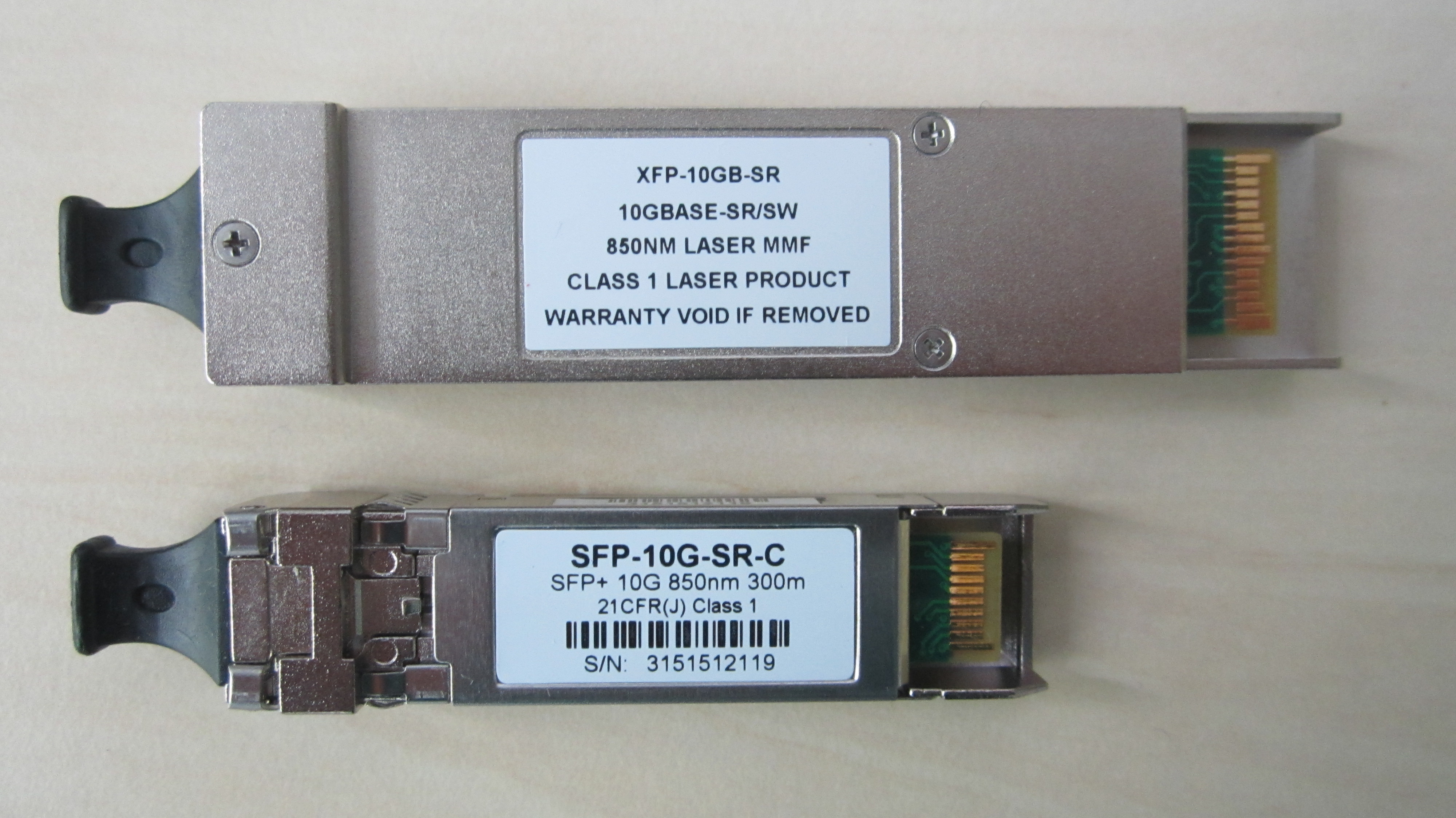XFP on:
[Wikipedia]
[Google]
[Amazon]
The XFP (10 gigabit small form-factor pluggable) is a standard for transceivers for high-speed computer network and telecommunication links that use optical fiber. It was defined by an industry group in 2002, along with its interface to other electrical components, which is called XFI.
XFP is a slightly larger form factor than the popular small form-factor pluggable transceiver, SFP and SFP+.
 The physical dimensions of the XFP transceiver are slightly larger than the original small form-factor pluggable transceiver (SFP). One of the reasons for the increase in size is to allow for on-board heat sinks for more cooling.
The physical dimensions of the XFP transceiver are slightly larger than the original small form-factor pluggable transceiver (SFP). One of the reasons for the increase in size is to allow for on-board heat sinks for more cooling.
Description
XFP modules arehot swappable
Hot swapping is the replacement or addition of components to a computer system without stopping, shutting down, or rebooting the system; hot plugging describes the addition of components only. Components which have such functionality are said ...
and support multiple physical layer variants. They typically operate at near-infrared wavelengths (colors) of 850 nm, 1310 nm or 1550 nm. XFP modules use an LC fiber connector type to achieve higher density.
Principal applications include 10 Gigabit Ethernet
10 Gigabit Ethernet (10GE, 10GbE, or 10 GigE) is a group of computer networking technologies for transmitting Ethernet frames at a rate of 10 gigabits per second. It was first defined by the IEEE 802.3ae-2002 standard. Unlike previous Eth ...
, 10 Gbit/s Fibre Channel
Fibre Channel (FC) is a high-speed data transfer protocol providing in-order, lossless delivery of raw block data. Fibre Channel is primarily used to connect computer data storage to servers in storage area networks (SAN) in commercial data cen ...
, synchronous optical networking (SONET) at OC-192 rates, synchronous optical networking STM-64, 10 Gbit/s Optical Transport Network (OTN) OTU-2, and parallel optics links. They can operate over a single wavelength or use dense wavelength-division multiplexing
In fiber-optic communications, wavelength-division multiplexing (WDM) is a technology which multiplexes a number of optical carrier signals onto a single optical fiber by using different wavelengths (i.e., colors) of laser light. This techniq ...
techniques. They include digital diagnostics that provide management that were added to the SFF-8472 standard.
The XFP specification was developed by the XFP Multi Source Agreement Group. It is an informal agreement of an industry group, not officially endorsed by any standards body. The first preliminary specification was published on March 27, 2002. The first public release was on July 19, 2002. It was adopted on March 3, 2003, and updated with minor updates through August 31, 2005.
The chair of the XFP group was Robert Snively of Brocade Communications Systems, and technical editor was Ali Ghiasi of Broadcom. The organization's web site was maintained until 2009.
XFI
The XFI electrical interface specification is a 10 gigabit per second chip-to-chip electrical interface specification defined as part of the XFP multi-source agreement. It was also developed by the XFP MSA group. XFI is sometimes pronounced as "X" "F" "I" and other times as "ziffie". XFI provides a single lane running at 10.3125 Gbit/s when using a 64B/66B encoding scheme. A serializer/deserializer is often used to convert between XFI and a wider interface such as XAUI that has four lanes running at 3.125 Gbit/s using8B/10B encoding
In telecommunications, 8b/10b is a line code that maps 8-bit words to 10-bit symbols to achieve DC balance and bounded disparity, and at the same time provide enough state changes to allow reasonable clock recovery. This means that the diff ...
.
Mechanical dimensions
 The physical dimensions of the XFP transceiver are slightly larger than the original small form-factor pluggable transceiver (SFP). One of the reasons for the increase in size is to allow for on-board heat sinks for more cooling.
The physical dimensions of the XFP transceiver are slightly larger than the original small form-factor pluggable transceiver (SFP). One of the reasons for the increase in size is to allow for on-board heat sinks for more cooling.
Types
XFP are available with a variety of transmitter and receiver types, allowing users to select the appropriate transceiver for each link to provide the required ''optical reach'' over the available optical fiber type (e.g.multi-mode fiber
Multi-mode optical fiber is a type of optical fiber mostly used for communication over short distances, such as within a building or on a campus. Multi-mode links can be used for data rates up to 100 Gbit/s. Multi-mode fiber has a fairly large ...
or single-mode fiber
A transverse mode of electromagnetic radiation is a particular electromagnetic field pattern of the radiation in the plane perpendicular (i.e., transverse) to the radiation's propagation direction. Transverse modes occur in radio waves and microwav ...
). XFP modules are commonly available in several different categories:
* SR - 850 nm, for a maximum of 300 m
* LR - 1310 nm, for distances up to 10 km
* ER - 1550 nm, for distances up to 40 km
* ZR - 1550 nm, for distances up to 80 km
The XFP packaging was smaller than the XENPAK form-factor which had been published earlier (by almost a year).
Some vendors supported both, or the XENPAK follow-ons called XPAK and X2.
See also
* Gigabit interface converter (GBIC) * QSFPReferences
{{Ethernet Fiber-optic communications Hot-swappable transceiver